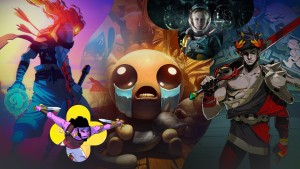Please support Game Informer. Print magazine subscriptions are less than $2 per issue
Diablo III
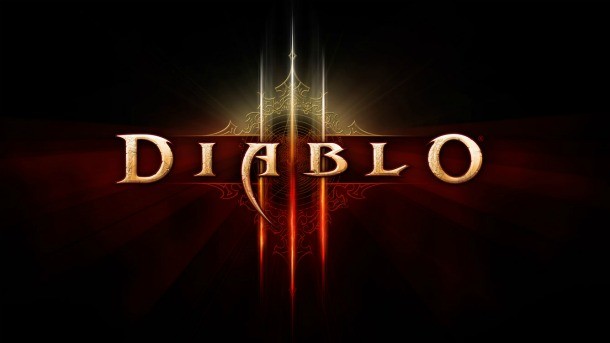
Perhaps the most important tidbit of information is the news we learned today: Diablo III releases May 15. We finally have a solid release date, one that hopefully won’t get pushed back.
What follows here is a greatest hits collection of our past previews of the game care of our own Adam Biessener, and any other details we have been able to steal away from Blizzard’s stronghold of secrets.
Classes
Each class uses a unique resource (two, in the Demon Hunter’s case). This has obvious advantages in terms of differentiating their playstyles, but don’t expect any big surprises in the mechanics. The Wizard’s fast-regenerating arcane power functions like Rogue energy in World of Warcraft. The Barbarian’s fury is basically WoW rage, building off of basic attacks and being consumed by more powerful strikes. The Witch Doctor’s mana is exactly what you’d expect. The Monk’s spirit gauge is interesting; it builds slowly as he uses normal attacks and is quickly depleted by using special skills. On the other hand, his specials generally don’t have cooldowns, so Monks can burst huge power at the expense of being relatively weak until they can re-energize their spirit. Finally, the Demon Hunter combines the concepts of mana and arcane power, using quick-replenishing hatred to fuel their offense and slow-recharging discipline to power defensive escapes.
Click here to read Phil Kollar’s personal experience with the Demon Hunter class.
Leveling
Blizzard has removed skill points entirely. Instead, you unlock skills as you level but can only equip a handful at a time (two to start, six eventually). It allows you to freely experiment with new spells.
When you hit new levels in the middle of battle, you can immediately bring new skills into your arsenal. Unlike Diablo II, which required players to commit early to dumping points into a single skill in order to be effective, all of the powers now automatically scale with your level.
The Rune system affords you the ability to alter (sometimes drastically) each of your skills in six different ways. It means that there is still a ton of room to create a unique build that plays the way you want it to.
Followers
Followers in Diablo III take the place of mercenaries from Diablo II: non-player characters that autonomously support you in combat. The system is unsurprisingly much more developed than the often kludgy mercenaries. Rather than choosing between hilariously imbalanced (life leeching unhittable barbarians) and pointless (mages that die in two hits and have all the firepower of a Super Soaker), you can develop your companions into customized support roles.
Followers aren't intended to contribute a lot to your direct damage, though you can make up for that to some extent with equipment and skill selection. Instead, each of the three followers primarily helps you out in a less face-smashing but still useful way. The templar can perform moderate tanking, the scoundrel can distract and misdirect your foes, and the enchantress can confuse their minds with her spells.
All three followers will join you along the adventure's critical path. Unlike the BioWare approach, they don't hand out sidequests or dramatically alter the path of the story. You can dig into their backstories by chatting with them in camp, but it's all lore fluff – you won't unlock an uber skill or a secret dungeon for doing so.
Though you can have just one follower active at a time, the other two hang out at your camp, conveniently sitting near your waypoint, and can be switched out for no cost. Respeccing them is a nominal gold fee, which goes up as you level but that Blizzard intends to be minor relative to your wealth at any stage of the game. Instead of dying and costing you a hefty resurrection fee, they get KO'ed at zero health and can be revived for free after the battle.
You can specialize each of the three followers between twelve skills that come in groups of three. Possibly more importantly, you can equip them with weapons, jewelry, and a class-specific item to customize their capabilities. Much of any Diablo character's power is tied to their equipment, and followers will be no different.
Followers cannot be controlled at all, not even with MMO-esque "aggressive/defensive/passive" commands. Blizzard toyed with the idea, but decided that those controls didn't mesh at all with fast-paced Diablo combat. Instead, the developers have focused their efforts on improving follower AI. Your adventure buddies will react to situations, like the enchantress casting a missile shield spell when facing archers or healing you when you're wounded. Follower behavior also changes depending on what skills you've given them, so hopefully a damage-specced templar will naturally be more aggressive than a defensively focused one.
Eirena, the enchantress - Part of a mysterious band of women led by an enigmatic prophet who she says is training them to prevent the end of the world, Eirena shares the same goal as the player. However, with the prophet and her sisters missing, Eirena is on her own until she meets up with you. In battle, the enchantress focuses on buffing the player while debuffing opponents with a variety of status effects.
Kormac, the templar - The templar order, like Diablo II's paladins, is dedicated to the eradication of evil in Sanctuary. Unlike those noble warriors, the templar also believe in the enrichment and empowerment of themselves. Once you rescue Kormac from a double-cross by a corrupted templar, he assists you in melee with his shield and spear.
Lyndon, the scoundrel - A disgraced member of the Kingsport thieves guild, Lyndon will flirt with anything remotely female and steal anything not bolted down. In exchange for your protection from his murderous former guild, Lyndon will happily shoot your foes with his heavy crossbow, use poison and distraction to cripple your enemies, and increase your chances of finding valuable gems and jewelry.
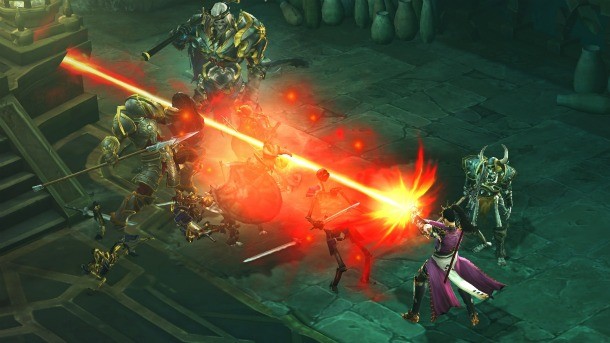
Artisans
The Artisan system allows players to create powerful magical items without making them hang around in town wasting time better spent killing monsters.
Two artisans will join you after you complete certain quests within the greater storyline. They will have names and backstories of their own, but for now we know them only by their trades.
All artisans have basic vendor functionality, allowing you to buy and sell items at your camp rather than shopkeepers in town. Beyond that, their capabilities vary greatly.
The blacksmith unsurprisingly focuses on equipment supporting close combat. Heavy armor, swords, axes, and the like can all be found here. He can also add sockets to items, allowing you to place an additional stat-boosting gem into an existing item. He can also repair any damaged equipment you may have and salvage items. Common (white) items will not be salvageable.
The jeweller focuses on gems. He can combine lower-grade gems into more powerful versions, and pop a previously socketed gem out of an item (preserving both the gem and the item in the process).
To fund these powerful abilities, you'll have to collect materials by breaking down existing items. The good news is that you can do it in the field, clearing space in your inventory by reducing bulky swag to easily stackable components. The bad news is that this has allowed Blizzard to remove town portals from the game entirely.
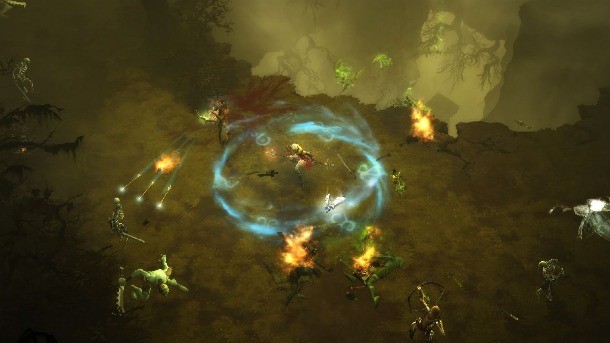
The Auction House
Each currency region will have its own auction house, accessible in-game. Players must pay a flat listing fee per item (though Blizzard is leaning toward giving everyone a small number of free listings per week), and set initial bids and buyout prices. Buyers can set their bids to automatically increase up to set levels rather than paying the buyout price, if they wish. When the item sells, Blizzard takes a flat cut of the sale, and the seller can choose to cash it out via a third-party payment processor (which will charge a percentage fee) or to leave it in their Battle.net account to use on any Blizzard digital product. These purchases could vary from full games to World of Warcraft subscriptions and sparkleponies.
Once you transfer your funds to Battle.net, though, you can't choose to cash it back out into currency. Getting money out of the system is a one-time opportunity at the time of the sale. Blizzard says that this is for legal reasons; apparently if the company lets players withdraw money at will, it would face many additional legal requirements like banks do.
Any item in the game can be put up for auction, and you can set the price wherever you like. Blizzard expects prices to stabilize in the single-digit dollar range for most good items, with perhaps a few exceptional ones making it to double digits. That sounds about right as a back-of-the-napkin estimate, based on what we've seen in secondary markets for other games.
Blizzard says it will not sell items directly. The auction house is strictly a player-to-player market – not that players would have any way to tell if the company slipped a few items into the economy, since the auction house is anonymous both ways. You'll never know who sold you an item, or who bought one of yours. There is no reason to assume bad faith on Blizzard's part here, but the fact remains that there is no transparency.
All cash transactions must go through the auction house. You can still trade with your friends and give them items in-game just like in Diablo II, but you can't make any trades involving cash outside the auction house.
A parallel in-game gold auction house will function identically with gold as the currency instead of dollars, euros, or pounds sterling. All of the functionality is shared between both markets.
Hardcore characters – in Diablo terms, characters that are deleted upon death – are excluded from the real money auction house. They can still use the gold auction house, but all hardcore characters are permanently barred from the real money side.
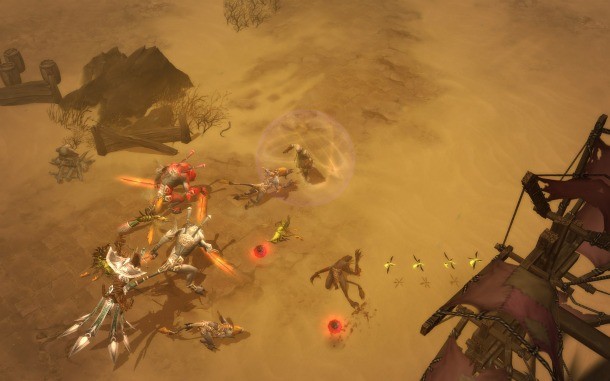
PVP
Blizzard recently announced that Diablo III’s PVP systems weren’t living up to the developer’s notoriously high standards, and would therefore be cut from the game before release.
Game director Jay Wilson said that the company felt that “delaying the whole game purely for PvP would just be punishing to everyone who’s waiting to enjoy the campaign and core solo/co-op content, all of which is just about complete.”
Blizzard also said that it would release a PVP patch sortly after the game released that would add multiple Arena maps with themed locations, PvP-centric achievements, and a matchmaking system.
Always Online
In defense of Diablo III always being online, Blizzard VP of online technologies Rob Bridenbecker said, "One of the problems we ran into back in the day was that we had two different, disjointed worlds that were being created." Blizzard always hated the fact that players had to start over with a new character to play online on Diablo II's closed Battle.net (a vastly superior experience to the hack-infested open Battle.net), losing their single-player offline progress. "Even the people that want to play alone eventually will want to play with other players," Bridenbecker said. "We wanted to remove that variable altogether."
Bridenbecker also pointed to the integrity of the game economy, especially with the inclusion of territory-wide auction houses for both real money and in-game currency, and how much easier the always-online requirement makes Blizzard's job of creating a hack-free, optimal experience for its players. "There are just way too many benefits to ignore," he said.
On the piracy front, Bridenbecker insisted that the game design aspects of the decision were a much larger priority. "You know, piracy is always the one that folks point their fingers at; you know, 'this is the reason that companies are doing that.' And for us, at the end of the day when you look at World of Warcraft, and StarCraft II, and even going back to Diablo II, Diablo, and the original StarCraft, we've always been about online play, so that's the dominant reason for the decision," he said.
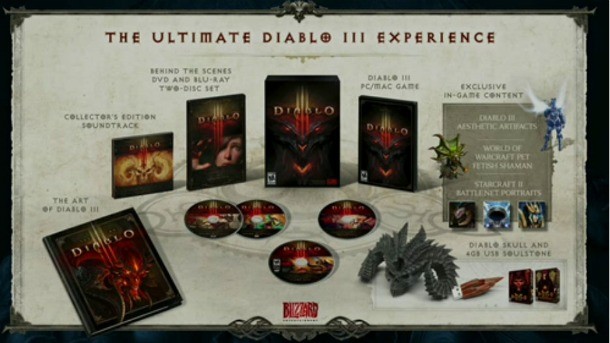
Collector’s Edition
Along with the game, you get an art book, soundtrack, and a behind-the-scenes Blu-ray. As less tangible rewards, you receive in-game items for Diablo III, WoW, and StarCraft II. Lastly, to satisfy your need for tchochke, you get a Diablo skull and a 4 GB memory stick that looks like a soulstone.
Trailers
The Black Soulstone trailer
Diablo III's opening cinematic
If you want more, our biggest preview of the game can be found here. It covers much of the information seen above, but also offers impressions by our resident Diablo expert, Adam Biessener.






















